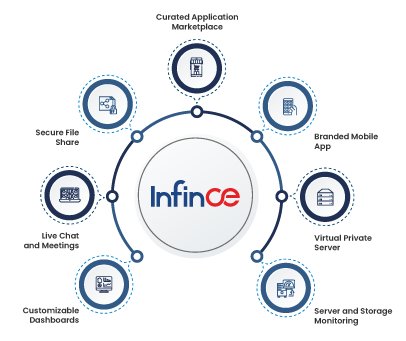Choosing the Right Pricing Model for Enterprise IT Services
The recent trends in digital transformation have paved the way for ensuring optimal business growth for enterprises. With the rates of public cloud adoption going up, it seems that leaders have recognized the potential of modern IT tools and technologies for generating better revenue. Simultaneously, organizations have also started to find alternatives to traditional IT infrastructure models and achieve improved agility in their operations.
Today, the cloud has become ideal for businesses to build enterprise applications at much lesser costs quickly. Cloud also allows them to utilize advanced technologies to scale their operations and stay competitive in the market. As new IT solutions are entering the industry every day, organizations need to identify the right platform to manage their workloads.
Read more: Private Or Public Cloud: Where Should My Business Invest?
Choosing the right pricing model for enterprise IT services
Partnering with a reliable IT services vendor like Infince gives organizations the option to run workloads on-premises and on the public cloud. This works to bolster the security of sensitive company data further while ensuring superior operational efficiency. Although adopting the best IT models is always the goal of a business, leaders also look for responsive technology partners that can offer IT solutions at the best costs. So, it’s crucial to choose the right pricing model.
There are predominantly two types of pricing models for enterprise IT services – subscription-based models and consumption-based pricing. Choosing the right pricing strategy allows a business to scale their IT resources up or down as needed while saving some money in the process as well.
The consumption-based approach is usually the go-to option for companies that want to make their business operations more agile. On the other hand, a subscription-based model suits those who want to keep their budget under control while benefiting from the potential of modern IT tools and technologies.
Read more: 5 Reasons For Small Businesses To Adopt SaaS Model
Listed in this blog are three principal business areas that are primarily affected by your IT pricing model’s choice.
1. Enterprise IT Operations
In the past, launching a new IT project required considerable hardware and software investments. Sometimes, it also needed months of planning and execution to get it right. Today, businesses demand faster solutions that will allow them to launch an IT project on the go. It can be facilitated easily by collaborating with an agile IT services provider.
A subscription-based model means that you will need to pay upfront for receiving the services, be it cloud solution or on-premise. Some vendors also allow customizing the features in their subscription models so that you can decide which elements you will need to optimize the IT operations of your company. As the costs are determined based on the length of the subscription, long-term plans often mean lower business costs.
On the contrary, the consumption-based IT model allows you to pay for the services you use. While this can be a good option for those who have trouble keeping their IT systems updated with software updates and patches, it will need you to cherry-pick the required tools and technologies every time you want to launch an IT project. So it is vital to choose an end-to-end IT solutions provider when going with the consumption-based pricing model.
Read more: Infince – A One Stop Technology Solution for Small Business
2. Running Workloads
Working with a reliable IT services vendor that will take care of everything from equipment maintenance and on-site configurations to training and support for your in-house team is always the best choice to stay ahead of competitors. That’s what Infince does for its customers. Infince’s technical concierge allows businesses to access IT support via phone, email, or live chat. The concierge helps you resolve the problem either by yourself or by arranging for a technician, depending on the challenge’s complexity.
When the IT vendor manages everything, a fixed recurring invoice can lead to better savings than paying every month. As subscription-based models are evolving, it gives you greater control and flexibility when choosing IT plans.
It also means determining your workload requirements adequately before choosing a pricing plan so that you can avoid all kinds of risks and keep a check on the costs. You can also use both public and hosted private clouds as per the plan to explore better opportunities to develop enterprise applications and services. Meanwhile, if you go with consumption IT plans, you can easily and quickly scale the IT resources on your terms and effectively run the workloads.
Moving between public clouds and on-premises setups can also be much cost-effective when it is consumption-based pricing. Enterprises can easily choose the business-critical applications necessary to improve performance or deal with any latency issues. Likewise, it can also be beneficial to pull back the workloads with highly sensitive business data that cannot be left off-premises.
Read more: How can modern IT management software empower companies to be more agile?
3. Capacity Planning
IT capacity planning needs companies to evaluate their resource utilization, workforce needs, and application usage before buying the servers, storage, and network infrastructure from a vendor. In this case, using a subscription-based service works out because businesses can have a predictable expense to manage their revenue stream. Moreover, subscription models also save on the costs of full purchases to gain access to the IT tools required to cover their demands.
On the contrary, the consumption-based model, or the pay-as-you-go approach, allows organizations to make an immediate purchase for their unplanned IT decisions. This can help deal with sudden demand peaks that cannot be managed with the existing infrastructure. This also means that those who are not adept with capacity planning can benefit from consumption-based IT pricing strategies. A reliable vendor can also help you determine future capacity requirements and see if the resources are enough to meet those upcoming demands.
A subscription-based model can be a boon to businesses that need an all-in-one platform for their enterprise needs. For instance, Infince offers a vast pool of features to support the business’s changing needs for fixed pricing. Customers can also personalize the plans with added resources to match their current and planned needs, which will lead to better operational efficiency and productivity.
Read more: 5 Points To Consider While Choosing Your Enterprise Collaboration Software
Selecting the right pricing model
Choose consumption-based IT model, if you:
- Prefer maintaining a more agile business operations approach
- Need to shift too often from public cloud to on-site system
- Cannot determine future peak demands precisely
- Want scalable IT resources for unplanned potential workloads
- Do not have dedicated personnel or the resources to manage any software updates or IT maintenance work
Choose subscription-based IT model, if you:
- Need a greater level of control and flexibility over your IT plans
- Prefer to have a predictable monthly expense
- Have the capacity planning done right based on the predefined budget
- Do not want to look for the required tools and technologies every now and then for new IT projects
- Want a comprehensive solution for managing everything from IT systems configurations to training and support
Choosing an all-in-one business management solution can help you become flexible and responsive to meet the customer demands and ensure optimal growth for your business in today’s competitive environment. The final decision to go with usage-based models or subscription approach should be based on your business’s actual requirements.
Want to know more about the flexible pricing plans offered by Infince for businesses of all sizes and capacities? Contact us!












































